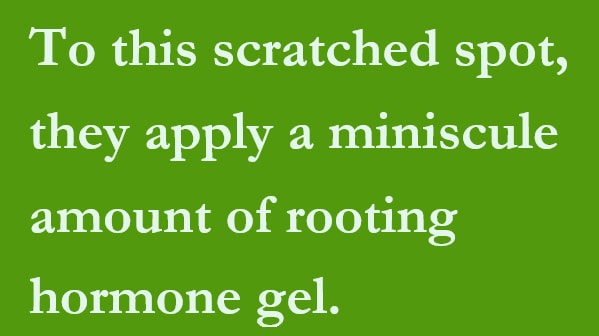|
To propagate or not to propagate ... that is the question.
I want to share a little with you about chimeras. First, let's define the word. Chimera is Swahili for "you'll be sorry." Chimeras are clearly the divas of the African violet world. Chimeras probably are more responsible for luring plant-loving people into the violet-growing hobby than any other force in the universe. They are unique, beautiful, temperamental and expensive. I used to think that it was a rip-off to see them priced at ridiculous amounts on eBay. Some of them cost more than $100 — egads! |
|
So, being the Do-It-Yourself Queen, I decided I could propagate them (much like my standard violets) fora fraction of that cost. I have been delusional in the past, but nothing comes close to this particular delusion.
I learned early on that you cannot just put down a chimera leaf like you can a regular violet leaf. Since they have mixed genes, some leaves will produce a bloom that looks nothing like the desired chimera — and other leaves will just laugh at you. You never know which personality will surface, but you can bet your sucker plucker it won't be the one you want. Sucker Propagation The methods of propagating these plants vary. I shall outline them briefly: The first way is to inspect your thriving chimera for suckers. No, not the sucker in the mirror. If you see a small independent set of leaves growing, barely noticeable under the main canopy, you might have a chance of removing it with a sharp sucker plucker or X-Acto knife. This requires a certain amount of dexterity and control (and in my case, Band-Aids). My first attempt at this was less than stellar, fortunately requiring no stitches. After you have removed this tiny leaf cluster you should settle it into moist soil in a cup with a lid to preserve humidity. Then wait for 6 to 24 months to see if it has the will to live. Rip Van Winkle probably awoke in time to see his plant take root and grow. Crown Propagation The second way is more brutal and should only be attempted after several drinks. If you are going to mess it up, it will hurt less that way. It is best to have 911 on speed dial. It involves removing the entire crown from a perfectly beautiful plant with the object of placing the decapitated crown into moist soil in a cup with a lid to preserve humidity and waiting for it to make roots. Or die. Then, you watch the indignant mother plant for signs of new leaves in the center of the plant around which the outer leaves have gathered to mourn the loss of their queen. If you are very lucky and extremely patient, you will eventually see several clusters of baby leaves emerge from this wasteland and grow. Later, you can remove them ever so carefully and root them as you did the suckers. It is a lot like playing the lottery. Sometimes you win, and sometimes you don't. And while you are waiting for new leaves to form you have the dubious honor of seeing your ugly, pillaged plant daily and hearing it call you disparaging names. Bloom Stalk Propagation The third way is to attempt to root a bloom stalk. After removing the fresh blooms and cutting the stem to about 1-inch length, place it in a sealed cup with the precise amount of moisture, the perfect temperature, the exact amount of light, and wait ... and wait ... and wait. I have not had much success with this method. The ratio has been "zip to zip" so far. All I have done is cheat myself out of enjoying the blossoms on the mother plant in the desperate hope one of the stems will root. Adding Rooting Hormone A new method I have recently seen on a YouTube video might have a ghost of a chance. The video recommends gently scratching the surface of the bloom stalk where the stem bifurcates to produce two blooms. We shall call this the "Y spot." To this scratched spot, they apply a miniscule amount of rooting hormone gel. They leave the blooms attached to the plant and watch for tiny little leaves to form at that Y-shaped junction on the stalk. When these leaf clusters are large enough, they are separated from the, bloom stalk and rooted like a sucker. I think this might have the best possibility of success. The good news about starting at zero is that you have nowhere else to go but up. So, if you have masochistic tendencies, if you thrive on insurmountable challenges, if you give up all hope of instant gratification, and if you are young enough to see the results before you die, then by all means grow and propagate chimeras. Or you can do what I do: pay the $100 and declare that it was worth every penny. |
|
Bloom Stalk Propagation
The third way is to attempt to root a bloom stalk. After removing the fresh blooms and cutting the stem to about 1-inch length, place it in a sealed cup with the precise amount of moisture, the perfect temperature, the exact amount of light, and wait ... and wait ... and wait. I have not had much success with this method. The ratio has been "zip to zip" so far. All I have done is cheat myself out of enjoying the blossoms on the mother plant in the desperate hope one of the stems will root. |
|
Adding Rooting Hormone
A new method I have recently seen on a YouTube video might have a ghost of a chance. The video recommends gently scratching the surface of the bloom stalk where the stem bifurcates to produce two blooms. We shall call this the "Y spot." To this scratched spot, they apply a miniscule amount of rooting hormone gel. They leave the blooms attached to the plant and watch for tiny little leaves to form at that Y-shaped junction on the stalk. When these leaf clusters are large enough, they are separated from the, bloom stalk and rooted like a sucker. I think this might have the best possibility of success. The good news about starting at zero is that you have nowhere else to go but up. So, if you have masochistic tendencies, if you thrive on insurmountable challenges, if you give up all hope of instant gratification, and if you are young enough to see the results before you die, then by all means grow and propagate chimeras. Or you can do what I do: pay the $100 and declare that it was worth every penny. |


